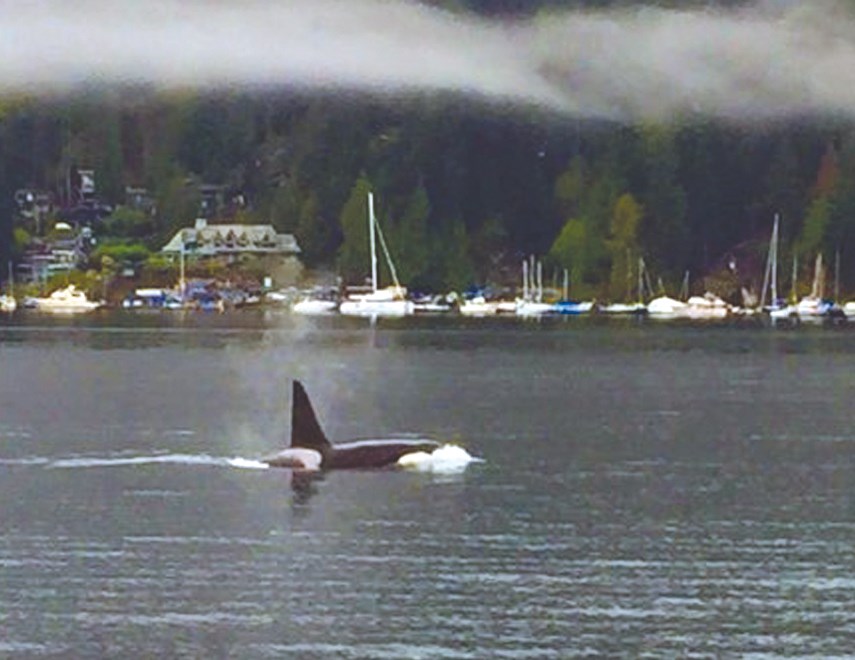Deep Cove residents witnessed a rare sight Tuesday morning when a pod of killer whales surfaced in their neighbourhood.
The orcas spent three hours in the inlet, venturing as far as Racoon Island in Indian Arm, and were seen again near Cates Park/Whey-ah-wichen around noon, according to reports received by the B.C. Cetacean Sightings Network.
Some members of the Tsleil-Waututh Nation, including Dennis Thomas, went out on a boat to get a closer look at the Bigg’s whales, also known as transient killer whales.
“It was amazing to experience this as they were passing right in front of Cates Park where we run our tours,” said Thomas, a guide with Takaya Tours.
It’s very uncommon for whales to travel east of the Second Narrows, said B.C. Cetacean Sightings Network co-ordinator Jessica Torode-Scott.
“They come into the harbour a few times a year, but usually not very far past first narrows, and not for very long,” explained Torode-Scott.
It’s the second time in as many weeks a pod of killer whales has been spotted in waters off the North Shore.
On April 16, orcas were seen gliding in the inlet near both the Second Narrows and Lions Gate bridges.
The Bigg’s whales venture into the Vancouver harbour to hunt seals.
Unlike resident killer whales, Bigg’s whales feed on marine mammals such as seals, sea lions, and other cetaceans including dolphins and smaller whales.
Government-sanctioned bounty hunting almost wiped out harbour seals in B.C. in the first half of the 20th century, but after the cull ended in 1968, the seal population recovered and stabilized.
The draw of available prey is leading to more sightings of Bigg’s killer whales for B.C. residents.
“Harbour seals are popular prey for these apex predators and they’re discovering hotspots where they can find an abundance of them – it appears the Vancouver harbour might be one of those spots,” said Dr. Lance Barrett-Lennard, director of the Marine Mammal Research program at Ocean Wise.
By looking at distinctive dorsal fins and saddle patches, members of Barrett-Lennard’s research team identified Tuesday’s group of whales as the T049As.
The group of five Bigg’s killer whales is comprised of matriarch T049A (a female born in 1986) and her four offspring: T049A1, an adult male born in 2001; T049A3, a juvenile male born in 2011; T049A4, born in 2014 – unknown sex; and T049A5, born in 2017 – unknown sex.
On April 16, observers saw a different group of Bigg’s whales: matriarch T101, born before 1973, with her three sons T102, born in 1984; T101A, born in 1993; and T101B, born in 1997.
Though still listed as “threatened” under the Species at Risk Act, B.C.’s population of Bigg’s killer whales is recovering, and now numbers more than 300, according to Ocean Wise statistics.
Barrett-Lennard and his team are conducting a multi-year photogrammetry study of killer whales in the Northeast Pacific Ocean.
The scientists use an unmanned multi-rotor aircraft, or drone, to collect high-resolution images they then analyze to measure growth rates and changes in body condition.
The research aims to determine whether killer whales are meeting their basic nutritional requirements, and to look at the impact of fluctuations in salmon abundance on body condition.
As well as northern and southern resident killer whales, the team is studying Bigg’s killer whales and humpbacks.
Historically, Indian Arm was heavily frequented by killer whales.
It’s certainly likely that they could return, now that they’ve figured out how to navigate their way up the Arm, according to Torode-Scott.
“If they had a successful hunt, the chances are even more likely,” she added.
While there has not been a recent count in Indian Arm, anecdotally it seems to be home to a fairly healthy seal population, said Torode-Scott.
There are approximately 110,000 harbour seals in the Salish Sea overall – a population that has remained stable for close to 20 years.



